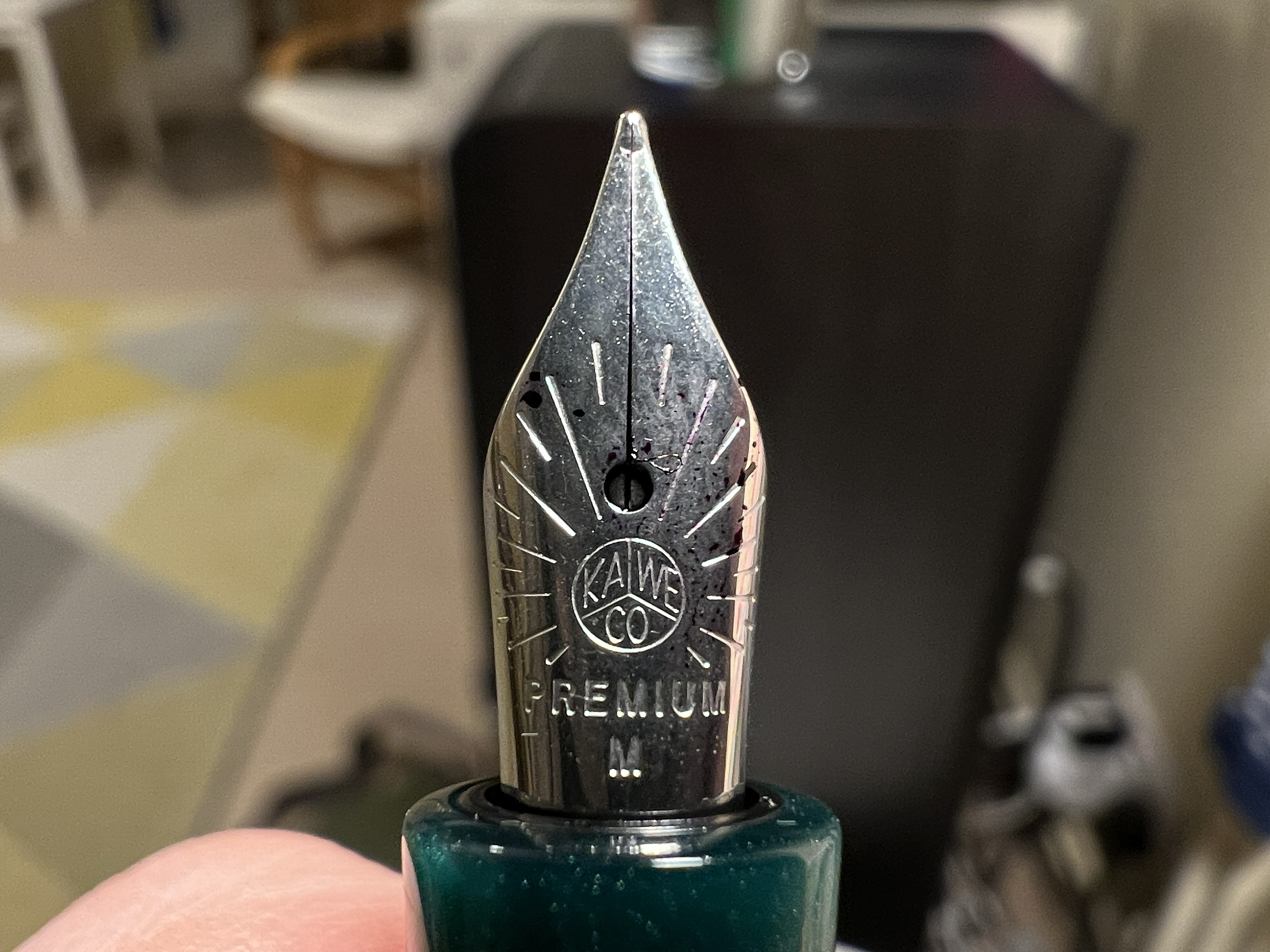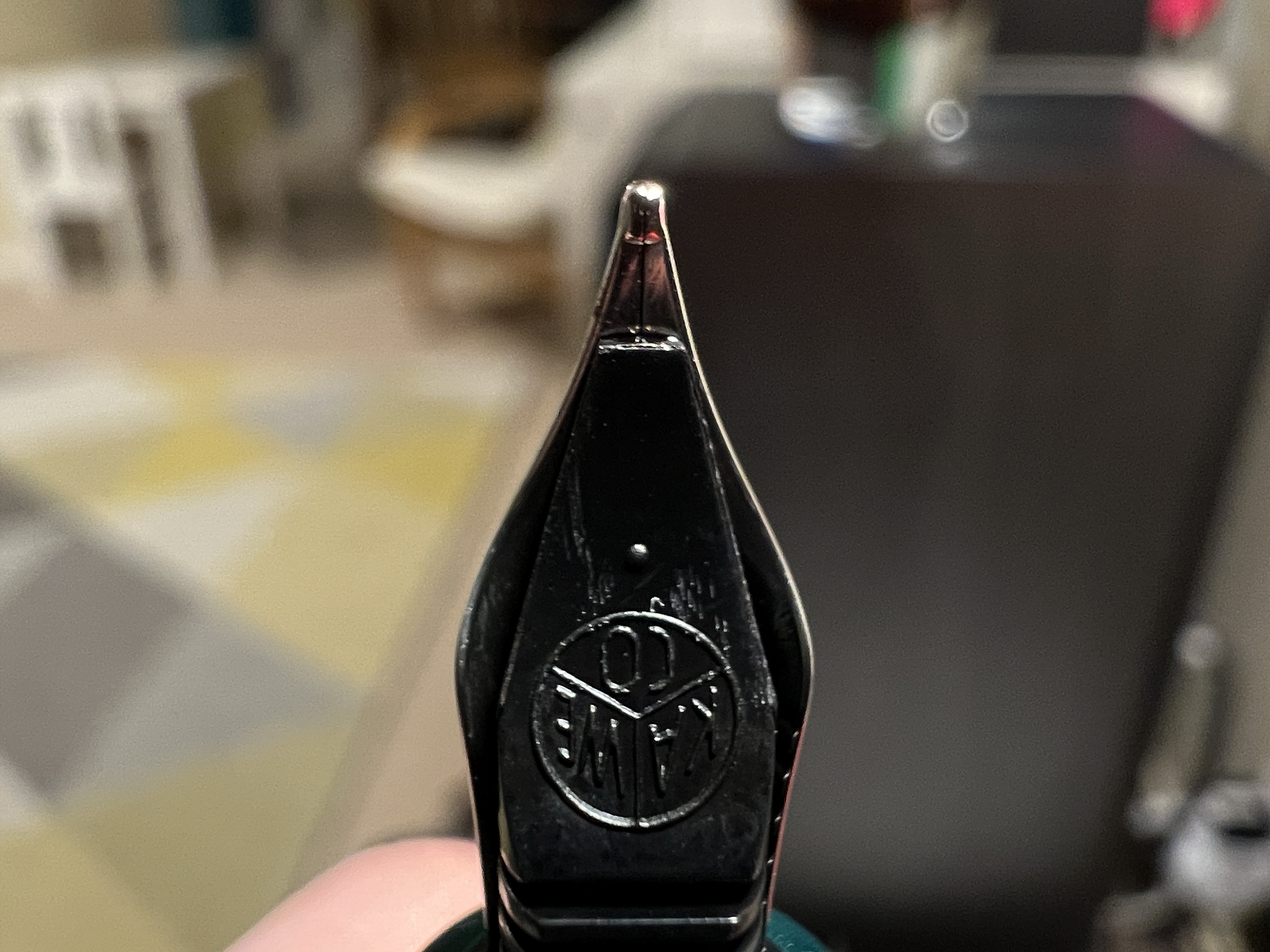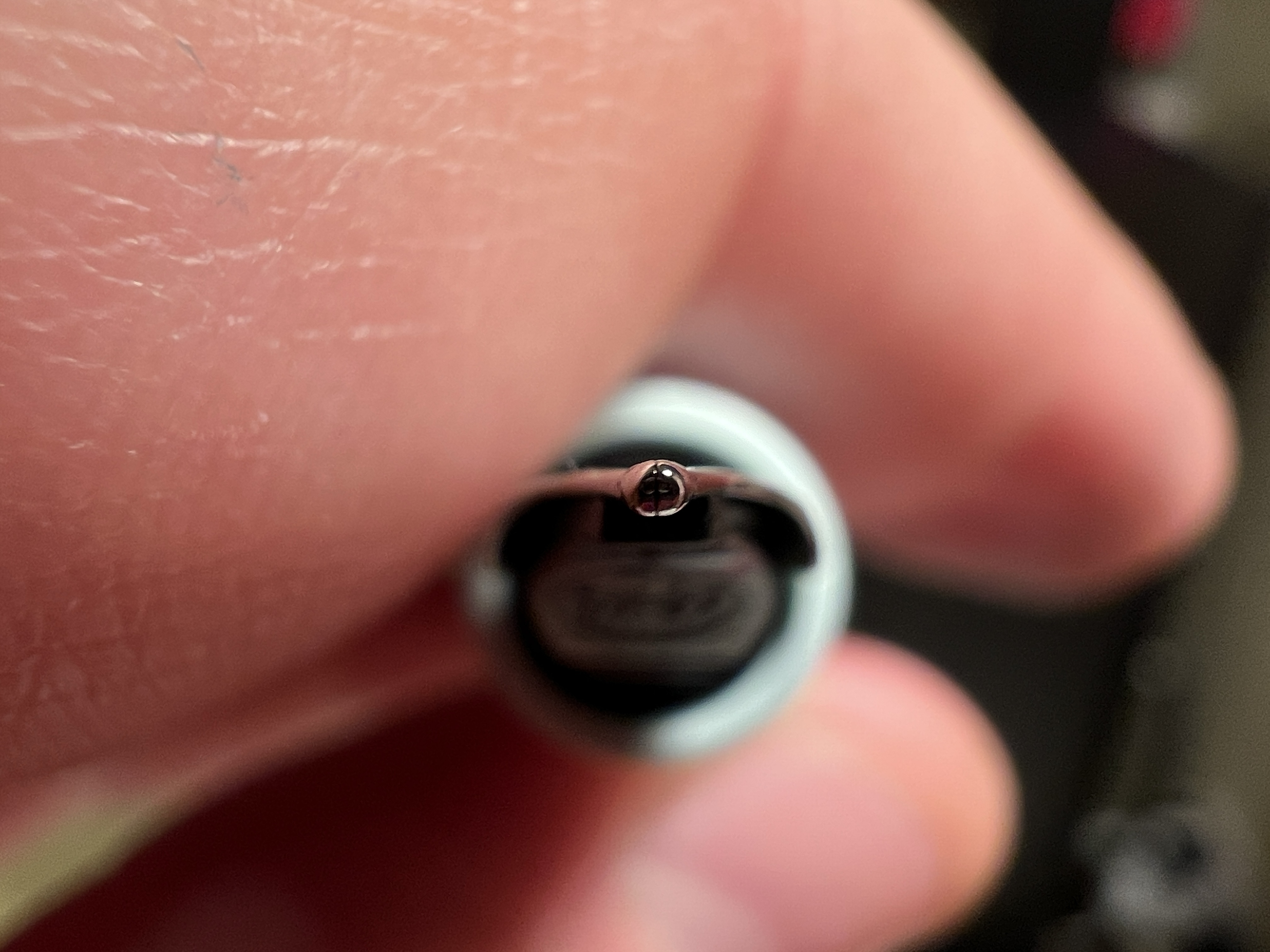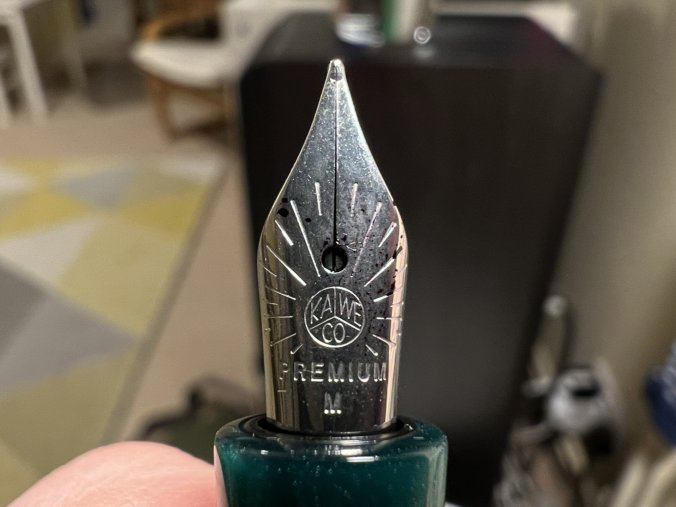In case you missed it, Kaweco has started offering a “Premium” nib unit for its pens with a screw-in nib, like the Brass and AL Sports. For about £35 you get a different nib imprint and a fancy metal tin with very pretty retro packaging, and some claims like this:
Those who focus on writing comfort and not on the material gold can now enjoy the unique writing pleasure of a gold nib with the Kaweco Premium Steel Nib. Apart from its beautiful, sun-shaped engraving, the larger iridium grain offers you perfect writing behaviour. Due to the hand-finished inner edge rounding, the nib glides smoothly and butter-softly over the paper. The manufacturing and the writing feel are comparable to the 14 kt. Gold nibs.
Bold claims. Do they stack up?
Let’s get down to it. In this review I’m putting a brand new, regular Kaweco Sport M nib, installed in a standard Sport, against a brand new Premium M nib, installed in a Kaweco Art Sport. I’m testing on the same paper, with the same ink, in the same position, at the same time.
I’m hoping that by comparing brand new nibs from the same vendor, we’re likely to get the truest and fairest comparison. Comparing instead say a five year old nib, especially one that’s been used, may reflect wear and different manufacturing/QC processes. So I went for brand new.
The Premium is still a steel nib, although it’s available in gold-plated variants and in the full range from EF to BB. That’s a very good start. And although I tested the M nib, the benefits of the Premium production process may be more beneficial on scratchy EF nibs or baby-bottomed BBs.
The nib imprint is, in my opinion, much more attractive than the normal Sport nib. It has a cool sunray effect. In the photos below, the Premium nib is always on the left.


The tipping is smoothly blended in to the nib, with a very rounded profile and high polish. It’s less bulbous than the standard and has a more elegant shape.


The slit is central, the two lobes of tipping are even, and they meet well. The marketing blurb claims a ‘larger iridium grain’, and in the shot below the tipping does look larger on the Premium.




I did a writing test side by side on Tomoe 68gsm lined paper, both using fresh cartridges of Kaweco Summer Purple.


Both nibs were smooth, with a steady flow. You can see from the flow of the shading that the nibs are almost identically wet. Neither had any softness or flexibility under pressure, and softness is one of the things I expect in a gold nib (to return to the claims at the start of this review). Both nibs wrote slightly wider on their downstrokes than their cross-strokes. Both wrote on their reverse sides, with the regular nib writing a rather nice fine line, actually, while the Premium was actually a little scratchy.
In normal grip, the Premium nib was totally silent and felt very smooth. The Regular nib was just a little audible and had a touch more tooth, but not in a problematic way.


Writing with the nibs almost horizontal on the page, the Premium nib was a little scratchy; the regular nib coped perfectly. Held vertical, both nibs wrote equally well. Writing fast, the regular nib had the edge in control, possibly because it’s not quite so smooth. Doing small printed letters, the regular nib wrote a slightly finer line that resulted in cleaner letter forms.
But you can see: I’m nitpicking. Both nibs wrote very well, straight out of the box. There’s hardly anything in it, and if I picked one or the other blind, to jot down some notes while on a call, I wouldn’t have been able to tell you which one it was just from the page feel or the resulting line. Sitting in a dead quiet room and concentrating hard, the Premium nib is quieter and smoother, but it’s an incremental improvement.
Can you predict the future?
This was both an easy and a hard review to write.
Easy, because the conclusion of my head to head boils down to this: if you can’t easily spot the difference between the two nibs, it’s probably not worth the extra cost to get the Premium version. And, as we’ve seen, I couldn’t.
Hard, because whenever I’m testing things side by side, I start to doubt my own methodology and judgement. Did I nudge the nib when screwing the unit in? Would the performance be different with someone else’s handwriting style? Etc.
But there is one important issue to discuss that makes this review hard to conclude. I have experienced myself over the years just how different Kaweco’s standard nibs can be, from one example to another.
Indeed, sat next to me right now I have another Kaweco Art Sport from the 2018 run, with its original unused medium nib, and I just tried it out. It writes a noticeably finer and toothier line than the 2021 M nibs I put head-to-head in this review. Is that because of sample variation, or changes in production over the past three years? I don’t know, but that’s beside the point — what it tells me as a buyer is that I can buy another Sport with an M nib tomorrow and I’ll have no confidence it’ll write the same as any of the three M nibs I have here.
Part of the value of the Premium nib, with its by-hand tuning and finishing, should be more predictable and consistent performance across the whole production run. This is exactly what we pen enthusiasts have been begging for from the likes of Visconti. We shouldn’t have to pay literally a Premium to assure it, but if that’s the only way, then I’ll take it. Ironically, I can’t test this claim of improved QC output without a much more scientific evaluation across a much larger number of nibs, and that’s beyond my patience. But I trust in the logic.
So the verdict.
Do I like the Premium nib? Yes, absolutely. It looks very pretty, and it writes really well.
Does it deliver the “unique writing pleasure of a gold nib” that it claims? That’s absolute nonsense, utter bollocks. It’s a firm steel nib. Move along, nothing to see here. If you want gold, you need to pay £190 and there’s no way round it.
Would I buy a Premium nib next time I pick up a Sport? Yes, probably: because I want my next Sport to write as well as this one — and that’s what a Premium QC experience should give you.
Both of the nibs reviewed in this post were supplied by Cult Pens. You can get your Kaweco fix right here.

That’s a remarkably passive aggressive bit of marketing copy, blimey. Seems like it’s not just not having their IP filings upheld where Kawco has an axe to grind
Frankly, I see this as an utter money grab. Kaweco nibs are not consistently tuned and often/usually require quite a bit of work. Why can’t Kaweco simply up their game with their standard nib and provide a product that writes consistently and beautifully out of the box? I resent having to spend a massive amount of money on the off chance it might provide a better writing experience. And talk about muddying the waters with the phraseology about ” gold nib writing experience.”
I’m a pretty heavy gold nib user but recently purchased a sport and decided to get the premium nib as an extra. Both in an EF. I have to say the standard nib was better than expected and the premium is very good. Smoother, but I agree with the review, not soft. Too smooth in fact that I think mine has a bit of bb. Does skip from time to time. The line on the premium is just slightly thicker as well but not enough to put me off – I tend to only write with an EF. The standard is slightly toothier, but that’s about it. For a proper comparison I would have liked to have seen the standard and premium side by side with the gold nib. I did deliberate on getting a gold nib but ended up thinking +100 gbp is better spent on a new pen altogether so went with the premium (wanted a gold tone nib so elected the premium rather than having two standards). Have to say the two new kaweco nibs I got are far more impressive than an f kaweco ss nib I have from 4 years ago. Very pleased with my purchase
Well it sounds like we’ve been through similar thought processes all round!
Agreed: I think Kaweco has got its house in order. The newer nibs are better than the old ones across the board. I have a recent F nib that is also good.
I would have liked to compare against the gold too, but neither the UK Kaweco distributor nor Cult Pens agreed to provide me one to test, and I don’t use a Sport enough in my own time to justify spending my own cash on one. 🙂
Thanks for the comment, Joseph.
Thanks, Anthony. I agree with your comments and the ones posted in reply. Instead of finding new ways to pull money out of our wallets, a lot of pen companies need to upgrade the quality of their regular nibs, whether gold or steel. Some, like Visconti, really need to get their nib act in order. They’ve become notorious for uneven, even bad, nib quality at every price point. Montegrappa isn’t very far behind. A beautiful pen that doesn’t write is a beautiful stick.
A good steel nib can be a pleasure to write with if it’s been properly made, but paying extra for a gold nib that disappoints as soon as you touch it to paper is really a form of abuse. Nibmeisters aren’t always doing fancy grinds; a lot of what they do is correcting bad nibs that came with new pens so you can actually write with them. Here again, the cost is transferred from the pen maker to you, the customer.
I’ve recently acquired a number of different vintage pens from the 1950s and 1960s with gold nibs. I am astounded how good gold nibs from that era actually are in comparison to those today, even those from the same maker. Yes, vintage pens often require some repair to make them function well, but that’s to the internal mechanics, not the nibs. There are quite a few reputable pen dealers who make sure the vintage pen you buy has been restored properly. It’s helpful to realize many of the better pens from the 1950s and 1960s have more in common with their contemporary counterparts than they do with those made before 1950.
This all reflects the transformation of the capitalism of the past to the capitalism of today. Profit was always the incentive, but in the past it was more tied to the concept of “making a better mousetrap” than your competitors, i.e., the quality of your product and its reputation. Today’s capitalism is often “how can we squeeze as much profit as possible by lowering the quality AND raising the price” so quarterly earnings increase enough to satisfy the conglomerate that owns us. For example, Pelikan is still made for the most part in Germany, but has been owned by a Malaysian conglomerate since the mid or late 1980s. The Pelikan nibs from the 50s and 60s are far superior to those they slap on their pens today.
The dominant form of today’s capitalism is obviously short-sighted. Profit can’t keep going up, so tactics like the frequent issue of the same pen in different colors are employed to stimulate sales (Visconti Homo Sapiens, Sailor 1911 and 3776, and others), and presently, Kaweco charging extra for a “premium” steel nib. We can easily see other tactics like this in use today.
The problem is the music will eventually stop in this game of musical chairs, because too many companies producing too many pens that are flooding the existing market for them can only end with bankruptcy for some and increasing quality problems for some others. We’re already seeing that happening, and it will continue. Hopefully the pen companies that survive will be the ones that still preserve some measure of quality at their price points.
Sorry if this all sounds like a rant, but considering the state of affairs today, a rant is in order.